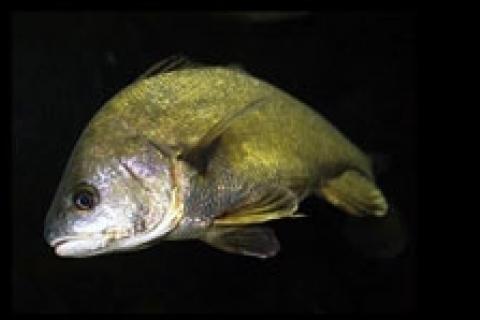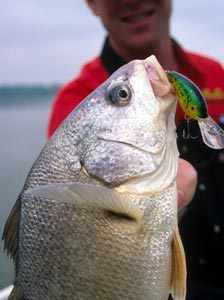
It's tough nowadays to find an abundant, delicious, easy-to-catch, hard-fighting, heavyweight sportfish that doesn't draw a lot of attention. And drum fans would just as soon keep it that way. Drum have the greatest latitudinal range of any North American freshwater fish ranging from Lake Winnipeg in northern Manitoba, Canada, south through the U.S. and Mexico to Guatemala.
Reflecting Back: The Best Fishing for Drum Advise I've Ever Received
The Mississippi River couldn't have been more beautiful that night. We were catfishing on a stretch in eastern Arkansas, with a canopy of bright stars above and a carpet of murmuring water below.
The bite was slow. Bill Peace and I sat quietly in his boat.
I hadn't noticed it earlier, but now, in the silence, I could hear what sounded like the distant beat of a bass drum. I remembered hearing the same sound when I was child curled up in the bottom of the boat, almost asleep, while my uncles fished through the night.
TIP: Fishing for Drum in many lakes and rivers is easy because they have the greatest latitudinal range of any North American freshwater fish. Click here to learn more about fishing for freshwater drum fish.
"Can you hear the drum singing, Bill?" I asked.
He said nothing for a long time, as if thinking. Then he told me a story.
"I heard them one night a long time ago when I was fishing here with an old river rat who lived in a shantyboat at the mouth of the White," Peace explained. "He said a long time ago one of those big paddlewheelers was steaming up the river not far from here. It was nighttime. The steamboat was all lit up, and the folks on board were having a good time. An orchestra was playing music. Then suddenly, the steamer hit a snag and sank. All the people on board were lost. The Mississippi just swallowed them up."
"The old man said that sound you hear is the sound of the orchestra that drowned. Every year, their ghosts come back and play the same eerie melody over and over again."
"You believe that?" I asked.
"Well, you and me both know it's just a bunch freshwater drum making that noise," he replied. "That's how they got the name drum. Every year when they're ready to spawn, the males start singing to their sweethearts and making that strange noise. Every time I hear it, though, I think about that old man's story, and I can almost see that paddlewheeler coming up the river and hear the orchestra playing inside."
I've often wondered if ghost stories like that are the reason folks don't fish much for freshwater drum.
It's always puzzled me. Here we have a fish with many endearing qualities. But the freshwater drum is ignored as a sportfish throughout its range. Why is that? I wonder.
Ghost stories could be the reason, I suppose. Or perhaps the drum is scorned because it has large, rough scales and a down-turned mouth like carps, suckers and other so-called "rough fish." Maybe it's because a hooked drum doesn't leap in spectacular fashion like a trout or bass.
There are plenty of good reasons you should fish for drum, though, despite the fact that many high-brow anglers consider them nothing but trash fish.
Reason No. 1: Drum fish are super-plentiful in many lakes and rivers.
Few Anglers Fish for Drum
I first started fishing for drum years ago on a hot August day when bass, bream and even catfish had a bad case of lockjaw. I was fishing a river in eastern Arkansas and had watched a man fishing from shore land several good-sized fish. From a distance, however, I couldn't tell for sure what he was catching. I paddled over to ask.
"Drum," he said. "When it's hot like this, they keep right on biting while other fish sulk like they have a belly ache. Just throw a night crawler out on the bottom and you'll catch one every time."
I did, and the old man was right. Every time I cast a big worm and let it sink to the bottom, I'd get a strike. Every time, it was a drum. I was quickly caught up in the fun, and during the next two hours, I caught more than 50 "gaspergous," as my Cajun friends call drum, including eight that weighed more than 10 pounds each.

It wasn't just the drum that got hooked. So did I. I've been an ardent drum angler ever since and have enjoyed many 100-plus-fish days, not just in summer, but year-round. Many anglers frown when they land a drum, but when fish provide action like that, they won't be the object of any prejudice from me.
Reason No. 2: Drum get big.
Drum Weigh Ten- to 30-Pounds & Fish Exceeding 40 Pounds are Possible
Another reason I came to love drum fishing is the size these brutes attain. My biggest weighed 32 pounds, but I know much bigger ones must lurk in many waters I fish. The world rod-and-reel record is a 54.6-pounder caught on Tennessee's Nickajack Lake in 1972. But considering the fact that few people harvest drum, chances are excellent that specimens exceeding that size swim in some waters. I hope I catch one someday.
During a lifetime of largemouth bass fishing, I've caught only one bass over 10 pounds, only 20 or so between 9 and 10 pounds, and a few dozen 8- to 9-pound fish. On several drum-fishing days, I've landed that many similar-size gaspergous in just a few hours, and on the best days, it's not unusual to catch a few 15- to 25-pounders. Granted, drum don't exhibit a largemouth bass' high-jumping acrobatics. But neither do catfish, and I love catching them, too. A jumbo drum is fun to catch, especially on light tackle.
Reason No. 3: Drum bite year-round.
Drum Will Bite in the Hottest Days of Summer to the Coldest Days of Winter
When I first started drum fishing, I thought of these rough boys as strictly hot-weather fish. But during the ensuing years, I've learned that drum bite readily from January through December, if you can find them.
Like many other sportfish, they tend to stay shallower during spring and fall, and lurk in deeper haunts in summer and winter. When I can pinpoint proper structure – deep holes, edges of bottom channels, steep ledges and the like – I tend to catch more during the hottest or coldest days in summer and winter when drum gather in big, dense schools. Spring fishing can be great, too, particularly when drum sing their love songs and gather to spawn. Fall fish feed actively but tend to scatter, making them more difficult to find.
Reason No. 4: Drum Are Easy to Catch
Freshwater Drum Like a Wide Variety of Baits and Lures
Adult drum eat many foods, including insects, mussels, crayfish and small fishes. Many baits entice them. I've caught drum on redworms, shad, crayfish, minnows and crickets, and on fishing lures that run the gamut from spinners, spoons and crankbaits to jigs, bladebaits and jerkbaits. I've hooked them while casting, trolling and bottom-fishing, in deep water and shallow, during day and night.
Among lures, I like small-hook jigs best (drum have small mouths and can't engulf a hook that is too large), especially for deep summer and winter fish. A 1-ounce model sinks quickly to the strike zone, and a few upward flips are all the action needed to entice a drum.
Night crawlers may be the best bait of all. Fish these on or near the bottom, impaling as many as you can on a No. 1 or 2 bait-holder hook. The wiggly ends of the worms quickly attract hungry drum.

variety of fishing lures,
including crankbaits, jigs,
spoons and spinners.
Reason No. 5: Drum Are Everywhere
Drum Have the Greatest Latitudinal Range of any North American Rreshwater Fish
Drum range from Lake Winnipeg in northern Manitoba, Canada, south through the U.S. and Mexico to Guatemala. They are most common within the Mississippi River basin, but can be caught in at least 27 states, from Montana, Nebraska and Texas in the west to Vermont, Virginia and Georgia in the east.
Reason No. 6: Drum Are Good to Eat
The Delicious Freshwater Drum Taste a Lot Like Redfish
For many years, I released all the drum I caught, believing they were too bony to eat – a fallacy based on information I often heard when I was a youngster. In fact, drums do not have the many small Y-bones found in carp and suckers. Filleting your catch and removing all dark red meat along the lateral line produces boneless fish that when cooked is firm, not flaky, and delicately flavored. I find it comparable to redfish, the drum's saltwater cousin, and consider it delicious grilled, broiled, baked, fried, smoked or made into chowder or bouillabaisse.
For the best taste, place your catch on ice immediately. If you put 'gous in a wire basket or on a stringer, they quickly die, and the flesh soon spoils.
My favorite drum recipe: Try this Mock Crab Meat dish. Bring to boil enough water to cover the amount of fish you are serving. Season the water with shrimp and crab boil, following the instructions on the bottle.
Drop the fish, which has been cut into finger-sized strips, into the seasoned water. Cook 3 to 5 minutes, then remove the pot from the fire, and let the fish soak for 15 minutes to pick up the seasonings. Drain, chill and serve with seafood cocktail sauce or hot melted butter.
Because their flesh is similar to that of redfish, freshwater drum also substitute well in blackened redfish recipes. My family likes drum fillets simply brushed with butter, seasoned with lemon-pepper and grilled.
I've learned there are many anglers who target these fascinating fish. They're a secretive bunch, though. Perhaps it's the stigma that still goes with being a drum fisherman that keeps some quiet. I'd venture to guess, though, that most simply don't want drum fishing to catch on. It's tough nowadays to find an abundant, delicious, easy-to-catch, hard-fighting, heavyweight sportfish that doesn't draw a lot of attention. And drum fans would just as soon keep it that way.
- 196733 views

